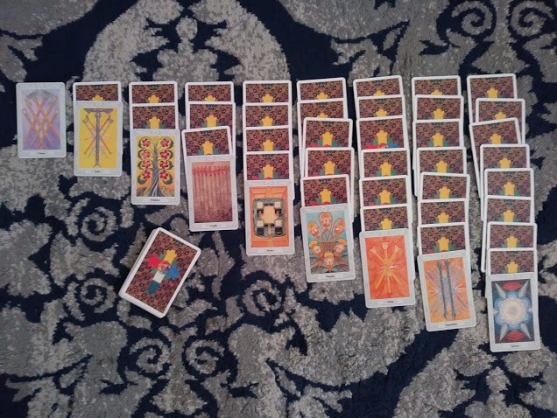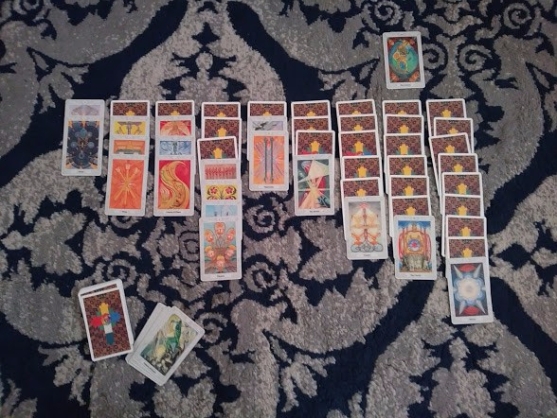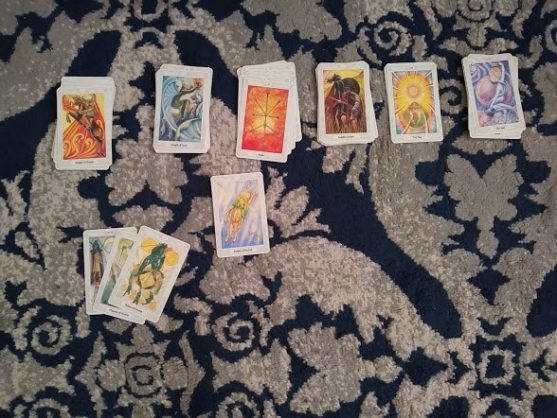I’ve always been a card shark. I grew up in Nevada, the land of hookers and gambling, and my formative years gave me a lifelong passion for card games. I’ll play just about any game with you, although I’ll never play for money. Hearts? I’m in. Bridge? I never learned how to do the whole auction gambit with the subtlety and panache it requires, but sure, I’ll play. Poker? Any time, as long as it’s Texas Hold ‘Em and none of that Five Card Draw crap. I still can’t really find anyone to play Cribbage with me, which is a tragedy, but I would if I could.
And, of course, there’s solitaire. (Solitaire? I should probably be consistent with the capitalization conventions, and I’ve capitalized the names of all other card games thus far. Okay. From here on out it shall be Solitaire.) I especially love playing Solitaire because I’m an only child, and I often had to amuse myself without the benefit of a card partner.
So it is unsurprising that young Jack should have at some point contrived a way to play Solitaire with a pack of Tarot cards.
I’m not the only person ever to have had this idea. Plenty of others have come up with their own versions, and not too many years ago an eminent member of the Aeclectic Tarot Forum posted a set of rules for Tarot Solitaire that’s not terribly dissimilar to my own. But the version I present here is my own, independent creation, from before I knew that anyone else had thought of Tarot Solitaire.

The basic rules of the game are the same as playing Solitaire with a poker deck. (A Poker deck? Augh, but consistency’s a bitch.) If you don’t know how to play Solitaire at all, read up on it here before you proceed any further. The modifications to the original game are as follows:
- Deal nine rows (a total of 45 cards) instead of seven rows (a total of 28 cards).
- Pentacles = Diamonds, Swords = Spades, Cups = Hearts, and Wands = Clubs. So the two passive suits (Pentacles and Cups) correspond to the red cards, and the two active suits (Swords and Wands) correspond to the black cards.
- Major Arcana may be stacked in descending order. For example, the High Priestess (Key II) may be stacked on the Empress (Key III) the same way a black Two would be stacked on a red Three.
- A Major Arcanum or a stack of Major Arcana may be placed on a blank space, the same way that a King would be.
- An individual Major Arcanum may be used as a “wild” card and stacked on top of any Minor Arcanum in lieu of the appropriate card. For example, the Empress may be stacked on the Ten of Wands in lieu of a “red” Nine (i.e. the Nine of Cups or Nine of Pentacles).
- This may only be done with one Major Arcanum at a time. A stack of multiple consecutive Major Arcana may not be placed on a Minor Arcanum. For example, if the Empress were placed on the Ten of Wands in lieu of a “red” Nine, it would not be permissible to then place the High Priestess on top of the Empress.
- Major Arcana used as “wild” cards may only be placed on Minor Arcana. A Major can only be placed on another Major in a descending, consecutive sequence.
- In addition to the four suit-sorting stacks above the tableau (the Guardian article I linked calls them “Foundations”, but that’s too pretentious even for my taste), you may start two stacks of Major Arcana: One in ascending order, starting with the Fool, and one in descending order, starting with the World. The goal of the game is to sort all the Minor Arcana and all the Major Arcana into these stacks.
I think that’s about as clear as I can make it. I’ll walk you through a sample game here, which will hopefully help. In the tableau above, I’ve drawn the Six of Wands (black), the Five of Wands (black), the Eight of Pentacles (red), the Nine of Swords (black), the Four of Pentacles (red), the Six of Cups (red), the Three of Wands (black), the Ten of Wands (black), and the Six of Pentacles (red). In my next move, I placed the red Four on the black Five, the black Three on the red Four, and the red Eight on the black Nine. (I’m not sure why I didn’t put the black Five on one of the red Sixes. Somehow I missed that.)

I played a bit more until I felt stuck, and then I drew three cards off the remaining pile. This is exactly the same way that one plays regular Solitaire.

As it happened, I drew the Prince of Cups (red; equivalent to the Knight in the RWS tradition), which I could put on the Queen of Wands (black). Eventually, the Universe (the World) showed up, so I popped it up top to start a descending-order stack.

At this point, I hit a wall. I ran out of legal moves with the Minor Arcana (or at least I ran out of ones I could see; I missed the really obvious Five of Wands). So I took the Hermit and placed it on the Six of Cups (red) in lieu of a black Five. From there, I was able to play the Four of Cups on top of the Hermit and continue with my game.

I stacked the Hanged Man (Key XII) on Death (Key XIII), moved a Knight (i.e. a King) over to a blank slot, and kept on playing. At some point, the Ace of Pentacles and the Foolish Man popped up, so I put them at the top of the tableau to start their respective stacks. When the Magus came along, I put him on top of the Fool.

Much to my astonishment, I almost won this sample game of Tarot Solitaire. By the time I finished, I had three complete stacks of Minor Arcana (Wands, Cups, and Pentacles) and had sorted almost all of the Majors. I had one stack that ran from the Universe down to the Sun, and another that ran from the Foolish Man all the way up to the Star. The only cards I wasn’t able to sort were the Moon and the Princess through Knight of Swords. I should have been able to sort these, as well, but I was careless in my game-play. Live and learn.

Now, as with all things Tarot, this game can have multiple layers of meaning. I think of it as two parts card game and one part divination. On the one hand, it’s a fun game and a good way to while away an hour or two; it need not be anything more than that. On the other hand, what I’ve laid out here is a full 78-card Tarot spread, and the very act of playing the game can show major themes and blockages in your life.
Pay attention to the cards you turn up over the course of playing the game. What do you have a lot of? What are you missing? Are there any cards that you know you need, but simply can’t access? Are you able to complete the game, or do you reach a sticking point?
Each time you don’t have a card and you use a Major Arcanum as a “wild” card, think about the potential divinatory meaning of that act. In my sample game, I couldn’t find a black Five (i.e. the Five of Wands or the Five of Swords), so I used the Hermit as a substitute. If I saw something like that in a reading for a client, I would suggest that my client was conflict-avoidant and had a tendency to withdraw into herself rather than face potentially tense situations with others. (And all of the angels in heaven above / And the devils down under the sea / Certainly know that conflict avoidance / Is characteristic of me.)
Also of note, although I didn’t have the presence of mind to photograph it, I advanced in sorting my Cups much more quickly than in any of the other suits. I had sorted through the Six of Cups before I had two of any other Minor suit, and before the Ace of Wands was even on the board. This suggests to me a kind of effluence of emotional matters, a predominance of the energy of Cups over the other suits.
And the most obvious, hit-you-over-the-head-with-a-frying-pan significance of this game is the final outcome. I wasn’t able to complete my game, because I was missing two crucial cards: The Moon and the Princess (Page) of Swords. (Yes, I was also missing the rest of the Swords Court, but the Princess was the hangup. Had I sorted her, the rest of the Court would have followed.) This, then, is the big blockage in my world right now. I have my own thoughts on what, exactly, these two cards in combination represent for me, but that’s personal enough that I doubt it belongs in a public blog post. At least, not in this public blog post; I suspect I’ll return to these themes in future writing.
I don’t often play Tarot Solitaire, but I wish I did. I went through a phase with it many years back, and I’ve fallen out of the habit. Even more rarely do I do this kind of game, where I use the Solitaire tableau as a prolonged, involved reading for myself. It’s incredibly intensive, and to properly use Solitaire as a Tarot spread requires a lot of time, a long attention span, and a willingness to take many, many notes. But it can also be a thought-provoking, meditative, deeply meaningful exercise.
If anyone tries this game, for fun or for divination, I would love to hear how it goes. And of course, the modifications I’ve given here are just my own version; feel free to tweak, pinch, and poke until you have a set of Tarot Solitaire rules that fit your fancy. Whether it’s for serious divination or just an afternoon diversion, Tarot Solitaire is kick-ass and I want to get more people into it.
You might also enjoy Matthew Lowes’ “Dungeon Solitaire: Labyrinth of Souls.” I’m a severe cheapskate, and this is one of the few purchases that I’ve never regretted. Check it out here: https://matthewlowes.com/games/ It has a 78-card poke-sized deck, but you can use any standard Tarot deck with the separately published rulebook. It’s a seriously good time – you might like it a lot.
LikeLike
Thanks! I’ll check it out.
LikeLike
Poker and solitaire are generic categories of games, and therefore uncapitalized. Texas Hold ‘Em is the title of a form a poker, and as a title is capitalized. The solitaire game most commonly called just “solitaire,” and which you riff on here, is Klondike.
LikeLike
Thank God for people who actually know the rules that govern capitalization conventions. This kind of thing keeps me up at night in cold sweats. I’d heard the name “Klondike” before, but I didn’t grow up with it. My first reaction when I hear that word is a sudden expectation that I will be asked to do something absurd in return for an ice cream treat.
LikeLiked by 1 person
This is interesting; thank you. I’m saving it for more detailed reading.
I have Marseille deck that I’ve split into majors and pips, and I’ve played solitaire with the pips alone. Hadn’t thought of using both sides of the deck together.
Thank you.
LikeLike
today I learned of your version of the game.
I played it one time and failed miserably.
It truly is a two headed monster.
I love it.
LikeLike
I have done tarot solitaire a similar way. Almost the same, but with majors I didn’t use them as “wild” cards, and Kings were still kings. Page and Knight were just their own thing. Also, on the divination side: I read the cards that I have left after losing. If I happen to win (which is rare), I take as there’s no message I need at the moment. Least not with this “spread.”
LikeLike